Investigating Stress among University Students: Detailed Report
VerifiedAdded on 2023/06/08
|6
|1257
|243
Report
AI Summary
This research report investigates stress among university students in Australia, focusing on engineering, dental, and medical students from five colleges. The study, utilizing a sample size of 1200 students, employs a self-administered questionnaire based on published literature and an online survey to assess sociodemographic factors, depression, anxiety, and stress levels using the DASS-21 scale. The questionnaire explores potential stressors categorized into academic, social/environmental, and lifestyle/health factors, with a cut-off point of 50% to determine contributing factors. The study reveals varying stress levels across different fields of education, providing valuable insights into the sources and prevalence of stress among university students. Desklib provides access to this and many other solved assignments for students.
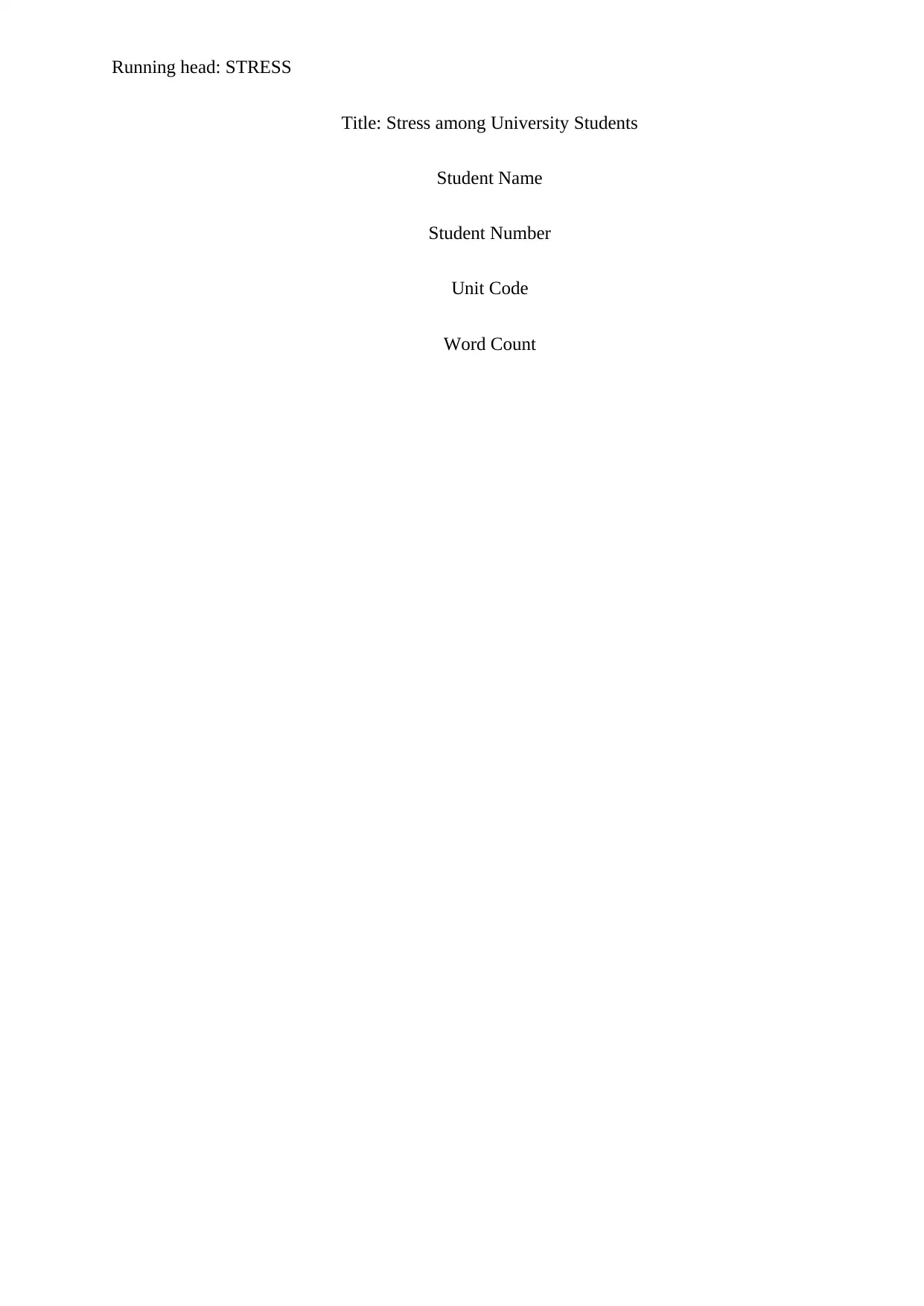
Running head: STRESS
Title: Stress among University Students
Student Name
Student Number
Unit Code
Word Count
Title: Stress among University Students
Student Name
Student Number
Unit Code
Word Count
Paraphrase This Document
Need a fresh take? Get an instant paraphrase of this document with our AI Paraphraser
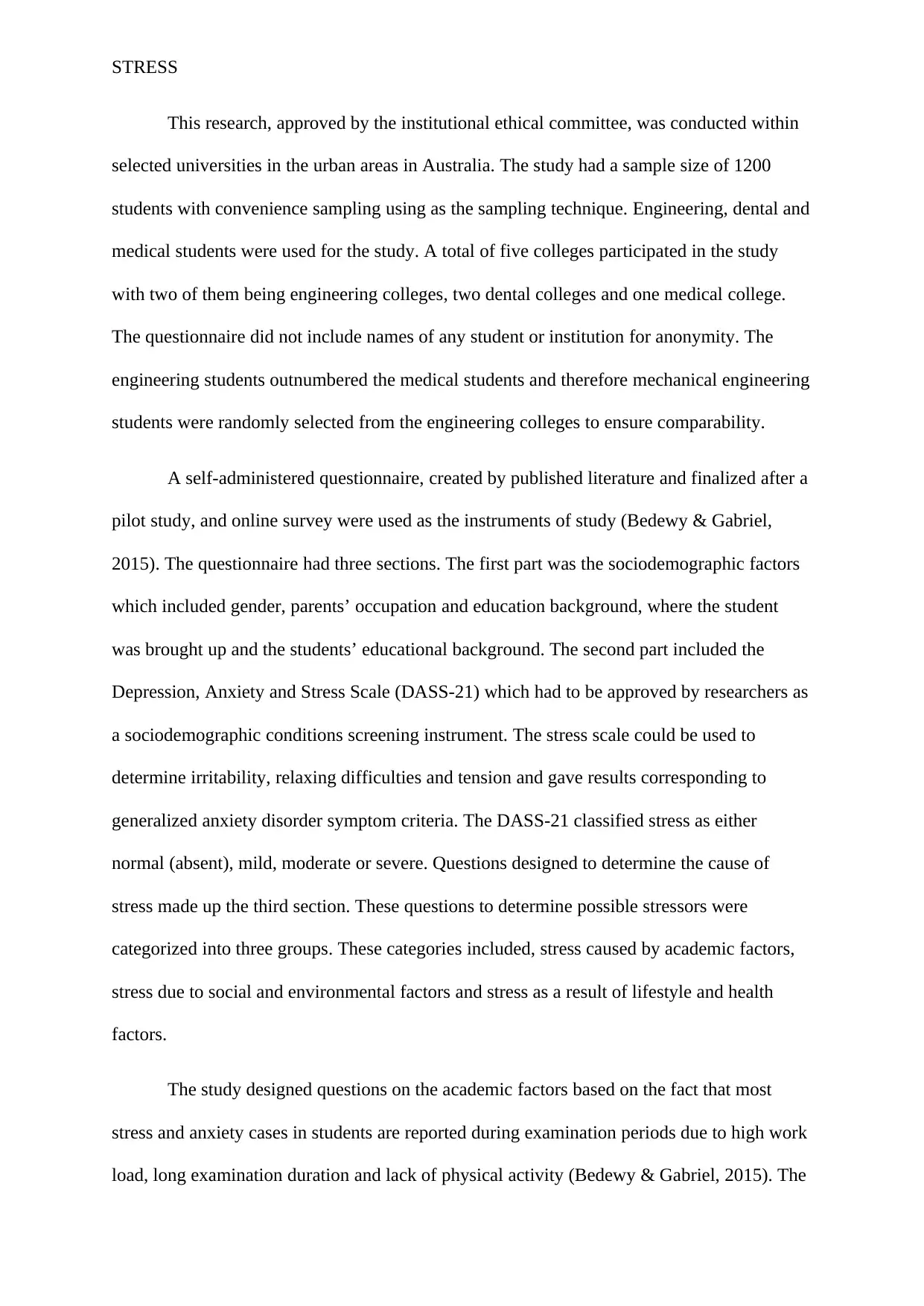
STRESS
This research, approved by the institutional ethical committee, was conducted within
selected universities in the urban areas in Australia. The study had a sample size of 1200
students with convenience sampling using as the sampling technique. Engineering, dental and
medical students were used for the study. A total of five colleges participated in the study
with two of them being engineering colleges, two dental colleges and one medical college.
The questionnaire did not include names of any student or institution for anonymity. The
engineering students outnumbered the medical students and therefore mechanical engineering
students were randomly selected from the engineering colleges to ensure comparability.
A self-administered questionnaire, created by published literature and finalized after a
pilot study, and online survey were used as the instruments of study (Bedewy & Gabriel,
2015). The questionnaire had three sections. The first part was the sociodemographic factors
which included gender, parents’ occupation and education background, where the student
was brought up and the students’ educational background. The second part included the
Depression, Anxiety and Stress Scale (DASS-21) which had to be approved by researchers as
a sociodemographic conditions screening instrument. The stress scale could be used to
determine irritability, relaxing difficulties and tension and gave results corresponding to
generalized anxiety disorder symptom criteria. The DASS-21 classified stress as either
normal (absent), mild, moderate or severe. Questions designed to determine the cause of
stress made up the third section. These questions to determine possible stressors were
categorized into three groups. These categories included, stress caused by academic factors,
stress due to social and environmental factors and stress as a result of lifestyle and health
factors.
The study designed questions on the academic factors based on the fact that most
stress and anxiety cases in students are reported during examination periods due to high work
load, long examination duration and lack of physical activity (Bedewy & Gabriel, 2015). The
This research, approved by the institutional ethical committee, was conducted within
selected universities in the urban areas in Australia. The study had a sample size of 1200
students with convenience sampling using as the sampling technique. Engineering, dental and
medical students were used for the study. A total of five colleges participated in the study
with two of them being engineering colleges, two dental colleges and one medical college.
The questionnaire did not include names of any student or institution for anonymity. The
engineering students outnumbered the medical students and therefore mechanical engineering
students were randomly selected from the engineering colleges to ensure comparability.
A self-administered questionnaire, created by published literature and finalized after a
pilot study, and online survey were used as the instruments of study (Bedewy & Gabriel,
2015). The questionnaire had three sections. The first part was the sociodemographic factors
which included gender, parents’ occupation and education background, where the student
was brought up and the students’ educational background. The second part included the
Depression, Anxiety and Stress Scale (DASS-21) which had to be approved by researchers as
a sociodemographic conditions screening instrument. The stress scale could be used to
determine irritability, relaxing difficulties and tension and gave results corresponding to
generalized anxiety disorder symptom criteria. The DASS-21 classified stress as either
normal (absent), mild, moderate or severe. Questions designed to determine the cause of
stress made up the third section. These questions to determine possible stressors were
categorized into three groups. These categories included, stress caused by academic factors,
stress due to social and environmental factors and stress as a result of lifestyle and health
factors.
The study designed questions on the academic factors based on the fact that most
stress and anxiety cases in students are reported during examination periods due to high work
load, long examination duration and lack of physical activity (Bedewy & Gabriel, 2015). The
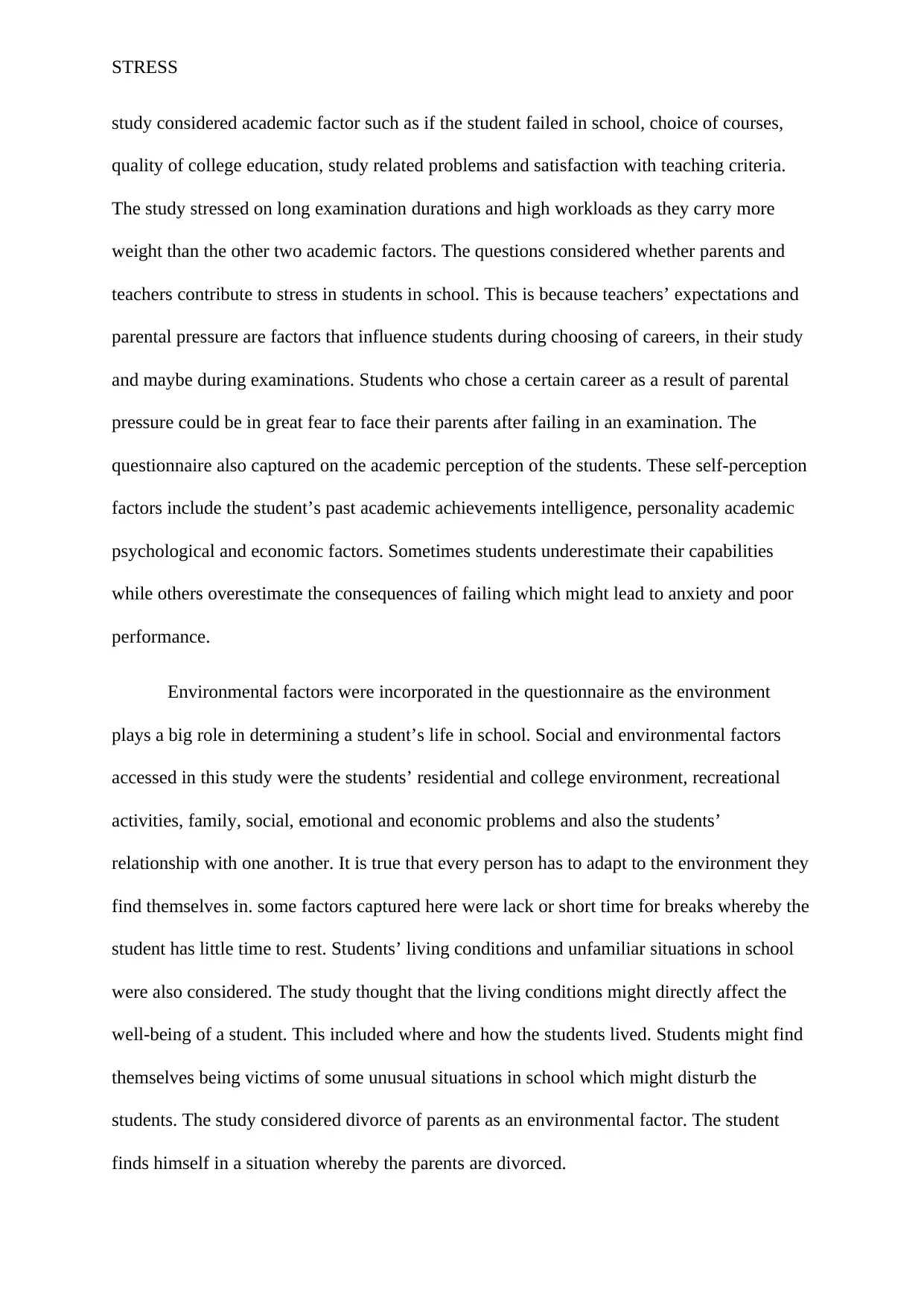
STRESS
study considered academic factor such as if the student failed in school, choice of courses,
quality of college education, study related problems and satisfaction with teaching criteria.
The study stressed on long examination durations and high workloads as they carry more
weight than the other two academic factors. The questions considered whether parents and
teachers contribute to stress in students in school. This is because teachers’ expectations and
parental pressure are factors that influence students during choosing of careers, in their study
and maybe during examinations. Students who chose a certain career as a result of parental
pressure could be in great fear to face their parents after failing in an examination. The
questionnaire also captured on the academic perception of the students. These self-perception
factors include the student’s past academic achievements intelligence, personality academic
psychological and economic factors. Sometimes students underestimate their capabilities
while others overestimate the consequences of failing which might lead to anxiety and poor
performance.
Environmental factors were incorporated in the questionnaire as the environment
plays a big role in determining a student’s life in school. Social and environmental factors
accessed in this study were the students’ residential and college environment, recreational
activities, family, social, emotional and economic problems and also the students’
relationship with one another. It is true that every person has to adapt to the environment they
find themselves in. some factors captured here were lack or short time for breaks whereby the
student has little time to rest. Students’ living conditions and unfamiliar situations in school
were also considered. The study thought that the living conditions might directly affect the
well-being of a student. This included where and how the students lived. Students might find
themselves being victims of some unusual situations in school which might disturb the
students. The study considered divorce of parents as an environmental factor. The student
finds himself in a situation whereby the parents are divorced.
study considered academic factor such as if the student failed in school, choice of courses,
quality of college education, study related problems and satisfaction with teaching criteria.
The study stressed on long examination durations and high workloads as they carry more
weight than the other two academic factors. The questions considered whether parents and
teachers contribute to stress in students in school. This is because teachers’ expectations and
parental pressure are factors that influence students during choosing of careers, in their study
and maybe during examinations. Students who chose a certain career as a result of parental
pressure could be in great fear to face their parents after failing in an examination. The
questionnaire also captured on the academic perception of the students. These self-perception
factors include the student’s past academic achievements intelligence, personality academic
psychological and economic factors. Sometimes students underestimate their capabilities
while others overestimate the consequences of failing which might lead to anxiety and poor
performance.
Environmental factors were incorporated in the questionnaire as the environment
plays a big role in determining a student’s life in school. Social and environmental factors
accessed in this study were the students’ residential and college environment, recreational
activities, family, social, emotional and economic problems and also the students’
relationship with one another. It is true that every person has to adapt to the environment they
find themselves in. some factors captured here were lack or short time for breaks whereby the
student has little time to rest. Students’ living conditions and unfamiliar situations in school
were also considered. The study thought that the living conditions might directly affect the
well-being of a student. This included where and how the students lived. Students might find
themselves being victims of some unusual situations in school which might disturb the
students. The study considered divorce of parents as an environmental factor. The student
finds himself in a situation whereby the parents are divorced.
⊘ This is a preview!⊘
Do you want full access?
Subscribe today to unlock all pages.

Trusted by 1+ million students worldwide
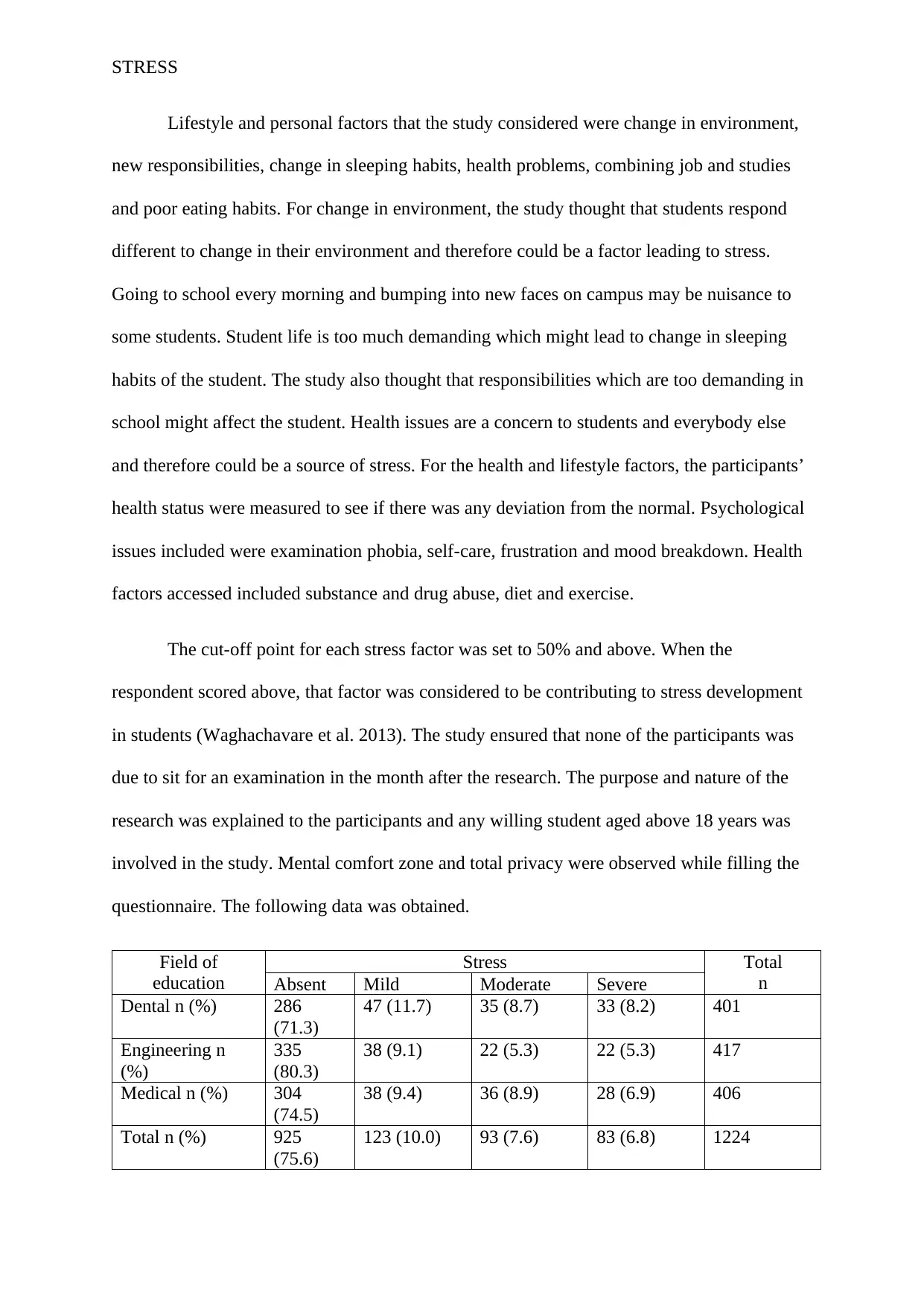
STRESS
Lifestyle and personal factors that the study considered were change in environment,
new responsibilities, change in sleeping habits, health problems, combining job and studies
and poor eating habits. For change in environment, the study thought that students respond
different to change in their environment and therefore could be a factor leading to stress.
Going to school every morning and bumping into new faces on campus may be nuisance to
some students. Student life is too much demanding which might lead to change in sleeping
habits of the student. The study also thought that responsibilities which are too demanding in
school might affect the student. Health issues are a concern to students and everybody else
and therefore could be a source of stress. For the health and lifestyle factors, the participants’
health status were measured to see if there was any deviation from the normal. Psychological
issues included were examination phobia, self-care, frustration and mood breakdown. Health
factors accessed included substance and drug abuse, diet and exercise.
The cut-off point for each stress factor was set to 50% and above. When the
respondent scored above, that factor was considered to be contributing to stress development
in students (Waghachavare et al. 2013). The study ensured that none of the participants was
due to sit for an examination in the month after the research. The purpose and nature of the
research was explained to the participants and any willing student aged above 18 years was
involved in the study. Mental comfort zone and total privacy were observed while filling the
questionnaire. The following data was obtained.
Field of
education
Stress Total
nAbsent Mild Moderate Severe
Dental n (%) 286
(71.3)
47 (11.7) 35 (8.7) 33 (8.2) 401
Engineering n
(%)
335
(80.3)
38 (9.1) 22 (5.3) 22 (5.3) 417
Medical n (%) 304
(74.5)
38 (9.4) 36 (8.9) 28 (6.9) 406
Total n (%) 925
(75.6)
123 (10.0) 93 (7.6) 83 (6.8) 1224
Lifestyle and personal factors that the study considered were change in environment,
new responsibilities, change in sleeping habits, health problems, combining job and studies
and poor eating habits. For change in environment, the study thought that students respond
different to change in their environment and therefore could be a factor leading to stress.
Going to school every morning and bumping into new faces on campus may be nuisance to
some students. Student life is too much demanding which might lead to change in sleeping
habits of the student. The study also thought that responsibilities which are too demanding in
school might affect the student. Health issues are a concern to students and everybody else
and therefore could be a source of stress. For the health and lifestyle factors, the participants’
health status were measured to see if there was any deviation from the normal. Psychological
issues included were examination phobia, self-care, frustration and mood breakdown. Health
factors accessed included substance and drug abuse, diet and exercise.
The cut-off point for each stress factor was set to 50% and above. When the
respondent scored above, that factor was considered to be contributing to stress development
in students (Waghachavare et al. 2013). The study ensured that none of the participants was
due to sit for an examination in the month after the research. The purpose and nature of the
research was explained to the participants and any willing student aged above 18 years was
involved in the study. Mental comfort zone and total privacy were observed while filling the
questionnaire. The following data was obtained.
Field of
education
Stress Total
nAbsent Mild Moderate Severe
Dental n (%) 286
(71.3)
47 (11.7) 35 (8.7) 33 (8.2) 401
Engineering n
(%)
335
(80.3)
38 (9.1) 22 (5.3) 22 (5.3) 417
Medical n (%) 304
(74.5)
38 (9.4) 36 (8.9) 28 (6.9) 406
Total n (%) 925
(75.6)
123 (10.0) 93 (7.6) 83 (6.8) 1224
Paraphrase This Document
Need a fresh take? Get an instant paraphrase of this document with our AI Paraphraser

STRESS
Below is a graph showing the number of students versus stress.
stress
0
100
200
300
400
500
600
700
800
900
1000
Chart Title
absent mild moderate severe
Below is a graph showing the number of students versus stress.
stress
0
100
200
300
400
500
600
700
800
900
1000
Chart Title
absent mild moderate severe
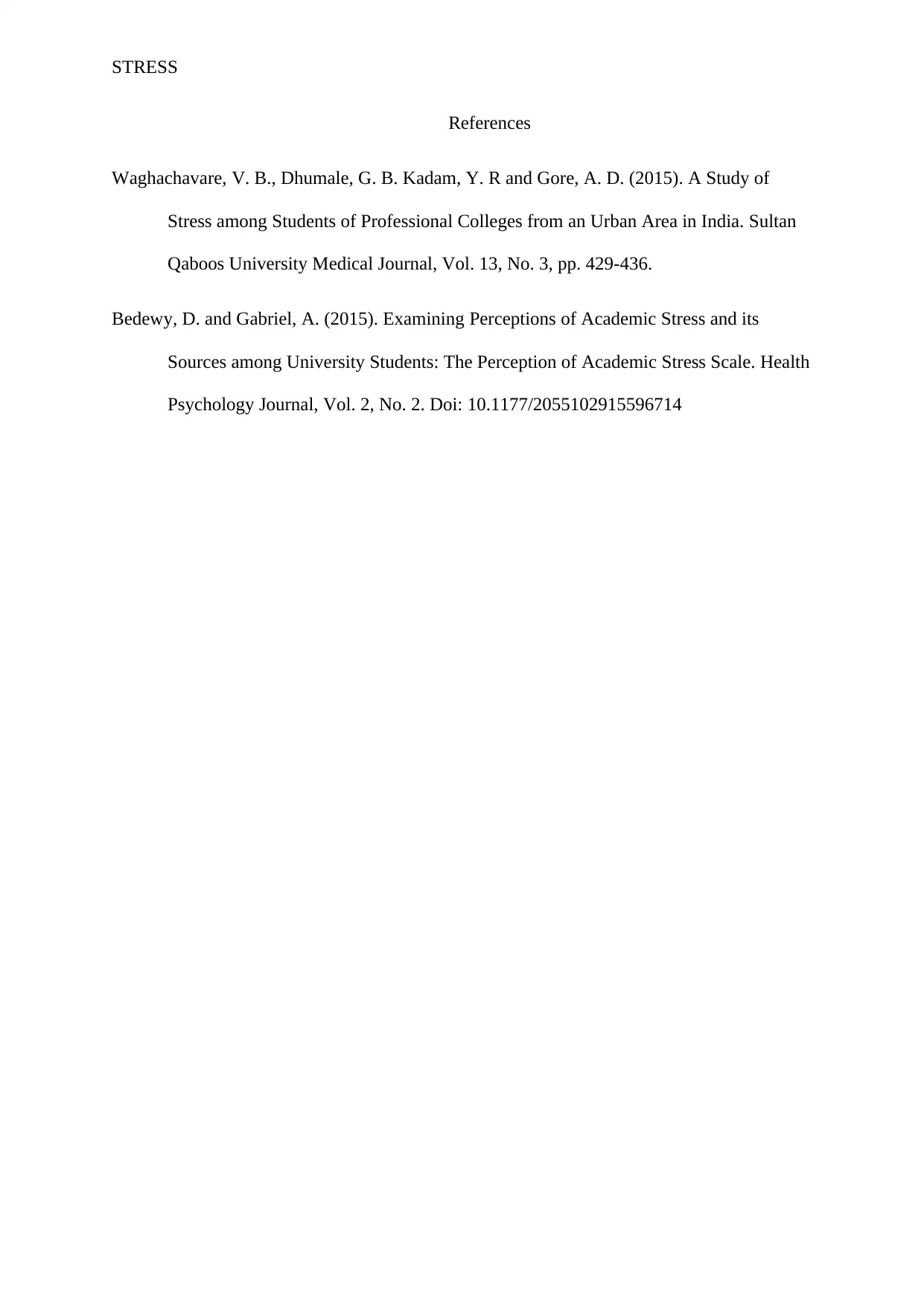
STRESS
References
Waghachavare, V. B., Dhumale, G. B. Kadam, Y. R and Gore, A. D. (2015). A Study of
Stress among Students of Professional Colleges from an Urban Area in India. Sultan
Qaboos University Medical Journal, Vol. 13, No. 3, pp. 429-436.
Bedewy, D. and Gabriel, A. (2015). Examining Perceptions of Academic Stress and its
Sources among University Students: The Perception of Academic Stress Scale. Health
Psychology Journal, Vol. 2, No. 2. Doi: 10.1177/2055102915596714
References
Waghachavare, V. B., Dhumale, G. B. Kadam, Y. R and Gore, A. D. (2015). A Study of
Stress among Students of Professional Colleges from an Urban Area in India. Sultan
Qaboos University Medical Journal, Vol. 13, No. 3, pp. 429-436.
Bedewy, D. and Gabriel, A. (2015). Examining Perceptions of Academic Stress and its
Sources among University Students: The Perception of Academic Stress Scale. Health
Psychology Journal, Vol. 2, No. 2. Doi: 10.1177/2055102915596714
⊘ This is a preview!⊘
Do you want full access?
Subscribe today to unlock all pages.

Trusted by 1+ million students worldwide
1 out of 6
Related Documents
Your All-in-One AI-Powered Toolkit for Academic Success.
+13062052269
info@desklib.com
Available 24*7 on WhatsApp / Email
![[object Object]](/_next/static/media/star-bottom.7253800d.svg)
Unlock your academic potential
Copyright © 2020–2025 A2Z Services. All Rights Reserved. Developed and managed by ZUCOL.




